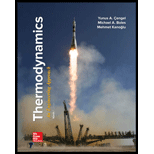
Concept explainers
Saturated humid air at 70 psia and 200°F is cooled to 100°F as it flows through a 3-in-diameter pipe with a velocity of 50 ft/s and at constant pressure. Calculate the rate at which liquid water is formed inside this pipe and the rate at which the air is cooled.
The rate at which liquid water is formed inside this pipe and the rate at which the air is cooled.
Answer to Problem 86P
The rate at which liquid water is formed inside this pipe is
Explanation of Solution
The amount of moisture in the air remains constant as it flows through the heating section as process involves no dehumidification or humidification.
Here, specific humidity at state 1 and 2 is
Express initial partial pressure.
Here, relative humidity at state 1 is
Express initial humidity ratio.
Here, pressure at state 1 is
Express initial enthalpy.
Here, specific heat at constant pressure is
Express specific volume at state 1.
Here, gas constant of air is
Express final partial pressure.
Here, relative humidity at state 2 is
Express final humidity ratio.
Here, pressure at state 2 is
Express final enthalpy.
Here, final specific enthalpy saturated vapor at temperature of
Express volume flow rate of the dry air at inlet.
Here, velocity at state 1 is
Express mass flow rate of air.
As the process is a steady flow and thus the mass flow rate of dry air remains constant during the entire process.
Here, the mass flow rate of air at inlet is
Express the rate at which liquid water is formed inside this pipe by using an water mass balance.
Here, mass flow rate of water at inlet and exit is
Express the rate at which the air is cooled by using an energy balance.
Here, the rate of total energy entering the system is
Conclusion:
Refer Table A-2E, “ideal-gas specific heats of various common gases”, and write the properties of air.
Refer Table A-4E, “saturated water-temperature table”, and write the saturation pressure and initial specific enthalpy saturated vapor at temperature of
Substitute
Substitute
Substitute
Substitute
Refer Table A-4E, “saturated water-temperature table”, and write the saturation pressure and final specific enthalpy saturated vapor at temperature of
Substitute
Substitute
Substitute
Substitute
Substitute
Substitute
Hence, the rate at which liquid water is formed inside this pipe is
Refer Table A-4E, “saturated water-temperature table”, and write the enthalpy of saturation liquid at temperature of
Here, enthalpy of saturation liquid at temperature of
Substitute
Hence, the rate at which the air is cooled is
Want to see more full solutions like this?
Chapter 14 Solutions
Thermodynamics: An Engineering Approach ( 9th International Edition ) ISBN:9781260092684
Additional Engineering Textbook Solutions
Starting Out with C++ from Control Structures to Objects (9th Edition)
Database Concepts (8th Edition)
Electric Circuits. (11th Edition)
Fluid Mechanics: Fundamentals and Applications
Elementary Surveying: An Introduction To Geomatics (15th Edition)
Starting Out with Programming Logic and Design (5th Edition) (What's New in Computer Science)
- Correct answer is written below. Detailed and complete solution only with fbd. I will upvote, thank you.arrow_forwardCorrect answer is written below. Detailed and complete solution only. I will upvote, thank you.arrow_forwardCorrect answer is written below. Detailed and complete solution with fbd only. I will upvote, thank you.arrow_forward
- Correct answer is written below. Detailed and complete solution only. I will upvote, thank you.arrow_forwardCorrect answer is written below. Detailed and complete solution with fbd only. I will upvote, thank you.arrow_forwardCorrect answer is written below. Detailed and complete solution only. I will upvote, thank you.arrow_forward
- Correct answer is written below. Detailed and complete solution only. I will upvote, thank you.arrow_forwardCorrect answer is written below. Detailed and complete solution only. I will upvote, thank you.arrow_forwardCorrect answer is written below. Detailed and complete solution with fbd only. I will upvote, thank you. Prefferably handwritten solution pleasearrow_forward
- Correct answer is written below. Detailed and complete solution with fbd only. I will upvote, thank you. Prefferably handwritten solution pleasearrow_forwardCorrect answer is written below. Detailed and complete solution only. I will upvote, thank you.arrow_forwardCorrect answer is written below. Detailed and complete solution with fbd only. I will upvote, thank you. Prefferably handwritten solution pleasearrow_forward
 Elements Of ElectromagneticsMechanical EngineeringISBN:9780190698614Author:Sadiku, Matthew N. O.Publisher:Oxford University Press
Elements Of ElectromagneticsMechanical EngineeringISBN:9780190698614Author:Sadiku, Matthew N. O.Publisher:Oxford University Press Mechanics of Materials (10th Edition)Mechanical EngineeringISBN:9780134319650Author:Russell C. HibbelerPublisher:PEARSON
Mechanics of Materials (10th Edition)Mechanical EngineeringISBN:9780134319650Author:Russell C. HibbelerPublisher:PEARSON Thermodynamics: An Engineering ApproachMechanical EngineeringISBN:9781259822674Author:Yunus A. Cengel Dr., Michael A. BolesPublisher:McGraw-Hill Education
Thermodynamics: An Engineering ApproachMechanical EngineeringISBN:9781259822674Author:Yunus A. Cengel Dr., Michael A. BolesPublisher:McGraw-Hill Education Control Systems EngineeringMechanical EngineeringISBN:9781118170519Author:Norman S. NisePublisher:WILEY
Control Systems EngineeringMechanical EngineeringISBN:9781118170519Author:Norman S. NisePublisher:WILEY Mechanics of Materials (MindTap Course List)Mechanical EngineeringISBN:9781337093347Author:Barry J. Goodno, James M. GerePublisher:Cengage Learning
Mechanics of Materials (MindTap Course List)Mechanical EngineeringISBN:9781337093347Author:Barry J. Goodno, James M. GerePublisher:Cengage Learning Engineering Mechanics: StaticsMechanical EngineeringISBN:9781118807330Author:James L. Meriam, L. G. Kraige, J. N. BoltonPublisher:WILEY
Engineering Mechanics: StaticsMechanical EngineeringISBN:9781118807330Author:James L. Meriam, L. G. Kraige, J. N. BoltonPublisher:WILEY





